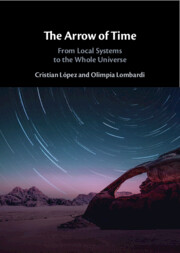Book contents
- The Arrow of Time
- The Arrow of Time
- Copyright page
- Contents
- Contributors
- Preface
- Acknowledgments
- Part I Local Systems
- 1 The Direction of Time: From the Cosmos to Local Systems
- 2 Thermodynamics with and without Irreversibility
- 3 Thermodynamics without Time
- Part II The Arrow of Time and Philosophical Issues
- Part III The Arrow of Time and Time-Reversal Invariance
- Part IV The Whole Universe
- Index
- References
2 - Thermodynamics with and without Irreversibility
from Part I - Local Systems
Published online by Cambridge University Press: 28 October 2025
- The Arrow of Time
- The Arrow of Time
- Copyright page
- Contents
- Contributors
- Preface
- Acknowledgments
- Part I Local Systems
- 1 The Direction of Time: From the Cosmos to Local Systems
- 2 Thermodynamics with and without Irreversibility
- 3 Thermodynamics without Time
- Part II The Arrow of Time and Philosophical Issues
- Part III The Arrow of Time and Time-Reversal Invariance
- Part IV The Whole Universe
- Index
- References
Summary
Working inside the control-theoretic framework for understanding thermodynamics, I develop a systematic way to characterize thermodynamic theories via their compatibility with various notions of coarse-graining, which can be thought of as parametrizing an agent’s degree of control of a system’s degrees of freedom, and explore the features of those theories. Phenomenological thermodynamics is reconstructed via the ‘equilibration’ coarse-graining where a system is coarse-grained to a canonical distribution; finer-grained forms of thermodynamics differ from phenomenological thermodynamics only in that some states of a system possess a free energy that can be extracted by reversibly transforming the system (as close as possible) to a canonical distribution. Exceeding the limits of phenomenological thermodynamics thus requires both finer-grained control of a system and finer-grained information about its state. I consider the status of the second law in this framework, and distinguish two versions: the principle that entropy does not decrease, and the Kelvin/Clausius statements about the impossibility of transforming heat to work, or moving heat from a cold body to a hotter body, in a cyclic process. The former should be understood as relative to a coarse-graining, and can be violated given finer control than that coarse-graining permits; the latter is absolute and binds any thermodynamic theory compatible with the laws of physics, even the entirely reversible limit where no coarse-graining is appealed to at all. I illustrate these points via a discussion of Maxwell’s demon.
Information
- Type
- Chapter
- Information
- The Arrow of TimeFrom Local Systems to the Whole Universe, pp. 12 - 55Publisher: Cambridge University PressPrint publication year: 2025
References
Accessibility standard: WCAG 2.1 AA
Why this information is here
This section outlines the accessibility features of this content - including support for screen readers, full keyboard navigation and high-contrast display options. This may not be relevant for you.Accessibility Information
Content Navigation
Allows you to navigate directly to chapters, sections, or non‐text items through a linked table of contents, reducing the need for extensive scrolling.
Provides an interactive index, letting you go straight to where a term or subject appears in the text without manual searching.
Reading Order & Textual Equivalents
You will encounter all content (including footnotes, captions, etc.) in a clear, sequential flow, making it easier to follow with assistive tools like screen readers.
You get concise descriptions (for images, charts, or media clips), ensuring you do not miss crucial information when visual or audio elements are not accessible.
Visual Accessibility
You will still understand key ideas or prompts without relying solely on colour, which is especially helpful if you have colour vision deficiencies.
Structural and Technical Features
You gain clarity from ARIA (Accessible Rich Internet Applications) roles and attributes, as they help assistive technologies interpret how each part of the content functions.
